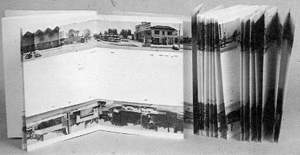Capturing a moment and manipulating the viewer's perception of it, could involve physically or digitally altering an image.
The Ambassadors (1553) by Hans Holbein. Note the skull in the middle of the painting, which when viewed from the far right and close up becomes "normal" to look at
It interests me to consider the ways you can view an image. Though incredibly interesting, I do not want to focus here on subjective experience. More, the ways in which the photographer can change the viewers experience of viewing, break from tradition and offer the viewer an alternative approach to seeing an image. Image manipulation has scope to be explored, both physically and digitally, to achieve such ends. I aim to explore the idea of anamorphosis as an unconventional way of seeing which would change the experience of looking at a photograph.
Anamorphosis is defined: 'a distorted projection or drawing which appears normal when viewed from a particular point or with a suitable mirror or lens.' A classical example of anamorphosis can be seen attached, in a painting by Hans Holbein. Conventional examples include painted road markings whereby the words written have to be viewed at an "unconventional" shallow angle, like when you approach them in a car, in order to be understood as standard. I hope to consider and explore how this practice can be applied in photography, a very simple idea I had was to concertina two images, which I have explained in more detail in the attachment. This is one way to physically manipulate the viewer's experience of looking, for without physically moving to look at the image(s), you would struggle to make sense of it.
One image would be stuck on the left sides of the concertina, and another image would be on the right sides of the concertina. When viewed head on you would get a very distorted overall image, and perhaps struggle to decipher what it is portraying. However if you walked to the left (and vice versa the right) and looked toward the image from that angle, you would see clearly one photograph.
Ed Ruscha's photobook On the Sunset Strip utilises the concertina to create an elongated line of images. Ruscha has taken control over how the viewer experiences his images, while I initially considered making use of the concertina in a slightly different way it is interesting to consider how this works as well, and I would be interested to experiment with my own images.
Considering physical manipulation of photographs I went out and photographed nature with my polaroid camera and while the images were still wet/developing, manipulated them with my hands to distort the images. Upon reflection I find the most successful image to be the one where you cannot necessarily tell what the image is of, in this case leaves, however when this information is divulged you can make sense of the image. This relates to some ideas I read about recently in the book, Thinking Fast and Slow by Daniel Kahneman; specifically "priming". Briefly, priming is an implicit memory effect in which exposure to a stimulus influences the response to another stimulus. In the case of my photograph I could prime the viewer with something other than leaves, because the highly distorted image is difficult to make out, and this would influence how they interpret the image. Which I think is an incredibly interesting concept.
Anaglyphs, otherwise known as 3D images provide a method of manipulating the viewer's experience of viewing. I have experimented with 3D in photoshop, but wanted to maintain a further sense of distortion and so I have edited an image which was heavily out of focus. The photo walk was the inspiration for a series of images I took where 'the world looks better in soft focus'. Following from this and keeping with the theme of nature I would like to get out and photograph some leaves or tree's in focus and repeat the photoshop experiment.







